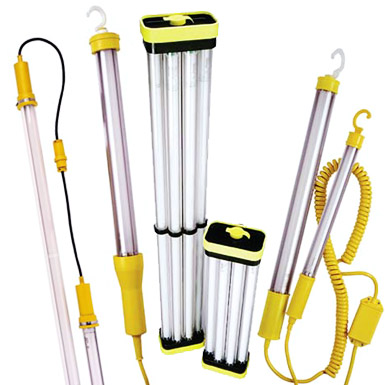 If you are working in non-illuminated area of your plant or warehouse or working outdoors during non-daylight hours, you are going to need to use a work light. The type of work light you choose depends on the type of job you are performing. While work lights come in a variety of strengths and sizes, there are four basic types of work lights:
If you are working in non-illuminated area of your plant or warehouse or working outdoors during non-daylight hours, you are going to need to use a work light. The type of work light you choose depends on the type of job you are performing. While work lights come in a variety of strengths and sizes, there are four basic types of work lights:
- Standing lamps — These work lights can be set up so that they are free-standing and can be aimed at whatever work area needs to be illuminated. They come in different sizes, from floor-standing models to tabletop lamps. They also are made with different bulb types. Make sure you select one that is sturdy enough to stand up to the inevitable abuse it will receive at a work site.
- Hanging lights — Also called “trouble lights”, these typically include a hook so they can be used hands-free and are battery-powered, although some models can be plugged into an electrical socket.
- Clamp lights — As the name implies, these lights can be clamped onto almost any surface, providing a constant light supply wherever you need it.
- Head lamps — These similar to high-powered flashlights that are attached to strap or headband that can be worn on the head. They aim light at whatever area you are looking at. They are frequently used to provide hands-free lighting in tight locations, such as behind a wall, under a car or piece of machinery, or anywhere else you can’t easily fit another kind of light.
Work lamps are made with a variety of different types of bulbs. Among the most common are fluorescent and compact fluorescent light (CFL) bulbs. Theses types of lights have the advantage of being cool to the touch and can provide a long-lasting light source that is also energy efficient.
Fluorescent bulbs give off a greenish light, which can affect the way some colors appear. Incandescent bulbs, or the typical light bulb, usually are housed inside a cage to prevent the bulb from shattering. While incandescent bulbs are less expensive than other work light options, they also need to be replaced more frequently. They also can become very hot, so they do present a burn hazard and also can affect the temperature of the work area. This is especially true if used in a confined space.
Light-Emitting Diode (LED) lighting is becoming an increasing popular option for work lights. These are solid-state semiconductors that emit light when a current passes through the. LED lights can last up to five times as long as CFL bulbs and even longer than incandescent bulbs. Some LED bulbs can last for more than 10 years before they require changing.
